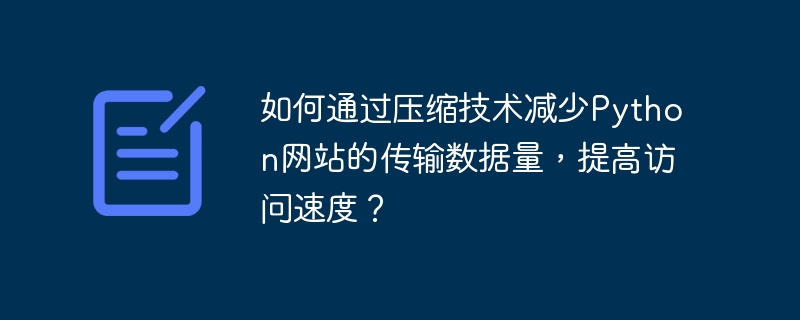

How to reduce the amount of data transmitted by the Python website through compression technology and improve the access speed?
Abstract: When building a Python website, reducing the amount of data transferred can significantly improve the website's access speed. This article introduces how to use compression technology to reduce the amount of transmitted data, including the use of gzip and deflate compression algorithms, and how to apply compression technology in mainstream Python frameworks such as Flask and Django.
Keywords: compression technology, transmission data volume, access speed, Python website, gzip, deflate, Flask, Django
Introduction
With the development of the Internet, the website Loading speed is increasingly concerned by users. When building a Python website, the amount of data transferred directly affects the loading speed of the website. In order to improve the user's access experience, we can use compression technology to reduce the amount of transmitted data, thereby increasing the access speed of the website. This article will introduce how to use compression technology to reduce the amount of data transmitted by Python websites, and provide corresponding code examples.
1. Use gzip compression algorithm
The gzip compression algorithm is a commonly used compression technology. It can perform lossy compression on text files and decompress them during transmission, thereby reducing the amount of data transmitted. In Python, we can use the gzip module to compress and decompress text files.
The following is a sample code using the gzip compression algorithm:
import gzip def compress_file(file_path): with open(file_path, 'rb') as file: compressed_data = gzip.compress(file.read()) with open(file_path + '.gz', 'wb') as compressed_file: compressed_file.write(compressed_data) def decompress_file(file_path): with open(file_path, 'rb') as compressed_file: compressed_data = compressed_file.read() decompressed_data = gzip.decompress(compressed_data) with open(file_path[:-3], 'wb') as file: file.write(decompressed_data)
Use the compress_file function to compress a text file, and use the decompress_file function to decompress the compressed file. By using the gzip compression algorithm, we can significantly reduce the amount of transmitted data and improve the access speed of the website.
2. Use the deflate compression algorithm
In addition to the gzip compression algorithm, there is also a commonly used compression algorithm is the deflate compression algorithm. The deflate compression algorithm is a lossless compression technology that can reduce the amount of data while maintaining the integrity of the transmission content. In Python, we can use the zlib module to compress and decompress text files.
The following is a sample code using the deflate compression algorithm:
import zlib def compress_file(file_path): with open(file_path, 'rb') as file: compressed_data = zlib.compress(file.read()) with open(file_path + '.deflate', 'wb') as compressed_file: compressed_file.write(compressed_data) def decompress_file(file_path): with open(file_path, 'rb') as compressed_file: compressed_data = compressed_file.read() decompressed_data = zlib.decompress(compressed_data) with open(file_path[:-8], 'wb') as file: file.write(decompressed_data)
Use the compress_file function to compress a text file, and use the decompress_file function to decompress a compressed file. By using the deflate compression algorithm, we can also reduce the amount of transmitted data and improve the access speed of the website.
3. Apply compression technology in Flask
Flask is a popular Python web framework that provides rich functions and scalability. To apply compression technology in Flask, we can take help of the Flask-Compress extension.
The following is a sample code for using compression technology in Flask:
from flask import Flask from flask_compress import Compress app = Flask(__name__) Compress(app) @app.route('/') def index(): return 'Hello, World!' if __name__ == '__main__': app.run()
Enable the compression function by importing the Flask-Compress extension and using Compress(app) in the application. In this way, when returning the response, Flask-Compress will automatically compress the response data, thereby reducing the amount of transmitted data.
4. Apply compression technology in Django
Django is another popular Python web framework with powerful functions and flexible design. To apply compression technology in Django, we can do it by configuring middleware.
The following is a sample code for using compression technology in Django:
# settings.py MIDDLEWARE = [ ... 'django.middleware.gzip.GZipMiddleware', ... ]
By adding 'django.middleware.gzip.GZipMiddleware' to MIDDLEWARE in settings.py, Django will automatically respond The data is compressed.
Conclusion
By using compression technology, we can effectively reduce the amount of data transmitted by the Python website and improve the access speed. In this article, we introduce sample code using the gzip and deflate compression algorithms and show how to apply compression technology in mainstream Python frameworks such as Flask and Django. By properly applying compression technology, we can improve the user's access experience and improve the performance of Python websites.
Reference link:
The above is the detailed content of How to reduce the amount of data transmitted by Python websites and improve access speed through compression technology?. For more information, please follow other related articles on the PHP Chinese website!